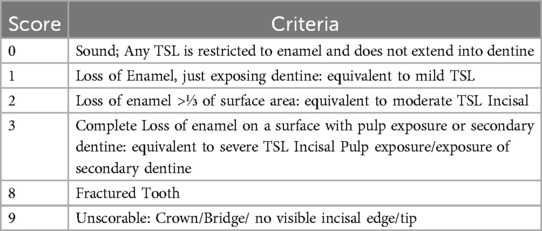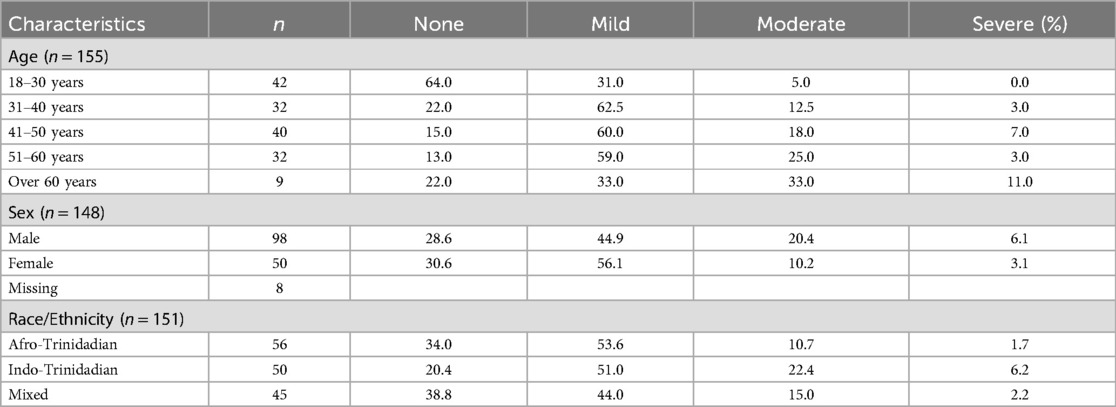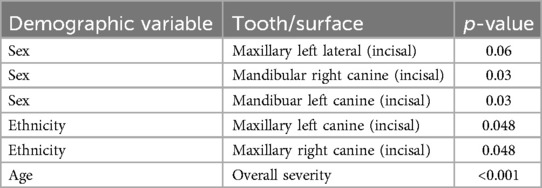- Unit of Restorative Dentistry School of Dentistry, The University of the West Indies St. Augustine, St. Augustine, Trinidad and Tobago
Introduction: This study aimed to assess the prevalence and severity of wear in a Trinidadian adult patient population based on the demographic variables of age, sex and ethnicity.
Methods: Secondary data, stored in an institutional repository as an SPSS file were re-coded. Age was re-coded to stratify the sample into five age groups. A new variable denoting the overall severity of tooth wear was added using the highest score for any examined tooth surface. Data for sex and ethnicity was not re-coded. Likelihood ratios on cross-tabulated data with an alpha level of 0.05 were used to ascertain significant differences in the overall severity of tooth wear for demographic variables. Cross-tabulations were also completed between demographic variables and individual scores for each examined surface in the upper and lower anterior sextants.
Results: There was a highly statistically significant association (p < 0.01) between age and the overall severity score of tooth wear in this sample patient population with 64% of 18–30-year-olds having no wear while only 22% of the over 60 age range showed no wear. There were no significant associations on cross-tabulated data for the overall severity score of wear and sex or ethnicity (p > 0.05). However, data on tooth wear of specific tooth surfaces when cross-tabulated with sex and gender showed significant associations (p < 0.05).
Conclusion: Age appears to influence the prevalence and severity of overall wear. The severity of wear on the incisal edges of specific teeth appears to be influenced, in part, by the demographic variables of sex and ethnicity.
Introduction
The worldwide prevalence rates for tooth wear vary from 29% to 60% depending on the geographical region of the studied sample population (1). Tooth wear is considered a significant oral condition important to public health practitioners and dental clinicians. Much of the epidemiological research on tooth wear has examined the association between etiological factors such as diet and habits and the prevalence of tooth wear in various populations (2, 3). Epidemiological research has also examined trends in prevalence in specific populations (4, 5). Several studies have shown a disproportionate prevalence of tooth wear in males compared to females (6, 7). The severity of tooth wear tends to worsen in older populations given the cumulative effects of exposure to an acidic diet or conditions causing contact of gastric acid with teeth and normal physiological wear of tooth-to-tooth contact. Comparative assessment of the prevalence and severity of tooth wear based on ethnicity has not been exhaustively explored in peer-reviewed literature.
Rafeek et al. concluded the prevalence rate of tooth wear in a patient population attending a teaching hospital in Trinidad was 72%, with 52% of the sample exhibiting mild wear (8). Gender, age, and ethnicity were collected as part of this study, however, the prevalence and severity of observed wear based on demographic variables of gender and ethnicity were not explored statistically (8). When age was examined as a demographic variable, there was a strong association between tooth wear and age using the inferential statistic of Odds Ratio (8). However, there is anecdotal clinical evidence that the prevalence and severity of tooth wear in this Trinidadian population predominately affects East Indians more than other ethnic groups in the population. Given the demographic profile of the population of Trinidad; in terms of ethnicity where there are approximately equal proportions of three major ethnic groups a comparative evaluation of the prevalence and severity of tooth wear is possible. The three dominant ethnic groups in Trinidad are as follows: Afro-Trinidadians, predominantly from Western Africa, Indo-Trinidadians, predominantly from South-East Asia, and a Mixed population of Afro and Indo-Trinidadians (9).
The present study aimed to assess the prevalence and severity of tooth wear in the Trinidadian adult patient population in different age groups, for both sexes, and the three dominant ethnicities in the Trinidadian population.
Methods
The original SPSS data from Rafeek et al, stored in an institutional repository, was used to facilitate this data analysis. One hundred fifty-five participants were examined as part of the original research from September 2002 to March 2003. The tooth wear index, developed by Smith and Knight and modified for the 1998 United Kingdom Adult Dental Survey, was used to ascertain the severity of wear on the teeth of the upper and lower anterior sextants as shown in Table 1. The descriptors for the severity of wear (none, mild, moderate, severe) are included in Table 1. The original research project involved three trained and calibrated examiners who ascertained the severity of tooth wear on the prescribed surfaces of teeth in the upper and lower anterior sextant. The buccal, lingual, and incisal edges of maxillary teeth and the incisal edges of mandibular teeth were examined, representing the teeth and surfaces examined in the 1998 UK Adult Dental Survey.
The SPSS data for age was re-coded to stratify the sample population into one of five age groups (18–30 years, 31–40 years, 41–50 years, 51–60 years, and over 60 years). A new variable denoting the overall severity of tooth wear was added using the highest score for any examined tooth surface to represent each participant's overall severity of tooth wear. Data for sex and ethnicity was not re-coded. Likelihood ratios on cross-tabulated data with an alpha level of 0.05 were used to ascertain significant differences in the overall severity of tooth wear for demographic variables. Cross-tabulations were also completed between demographic variables (age, sex, and gender) and individual scores for each examined surface in the upper and lower anterior sextants.
Results
Age
Table 2 shows the prevalence and severity of tooth wear in this sample by demographic group. There was a highly statistically significant difference (p < 0.01) between age and the overall severity score of tooth wear in this patient sample population with 64% of 18–30-year-olds having no wear while only 22% of the over 60 age range showed no wear. Considering mild wear, 62.5% of 31–40-year-olds showed mild wear compared to 60% of 41–50-year-olds and 59.0% of 51–60-year-olds. Severe wear was noted in 3% of persons in the 51–60 age range and in 11% of persons over 60 years.
Sex
There were no significant associations on cross-tabulated data for the overall severity score of tooth wear and sex (p = 0.27). However, when sex was cross-tabulated with the scores for the individual surfaces of teeth significant associations were noted for the incisal edges of three teeth (Table 3).
Ethnicity
Cross-tabulated data showed no significance for the overall severity score of wear and ethnicity (p = 0.63). Significant associations are presented for individual surfaces of teeth cross-tabulated with ethnicity in Table 3. For the upper left canine, persons identifying as predominantly Afro-Trinidadian showed no moderate or severe wear. For those identifying as Indo-Trinidadian, 10.6% demonstrated moderate wear while 6.4% demonstrated severe wear. Of persons identified as mixed, 0% exhibited moderate wear while 2.2% exhibited severe wear.
For the upper right canine, 74.5% of Afro- and 80% of Mixed-Trinidadians showed no evidence of wear while only 48.9% of Indo-Trinidadians showed no evidence of wear. Mild wear was noted in 23.5% of Afro-Trinidadians, 33% of Indo-Trinidadians, and 20% of Mixed-Trinidadians. Moderate wear was noted in 2% of Afro-Trinidadians, 9% of Indo-Trinidadians, and 0% of Mixed-Trinidadians. Severe wear was noted in 2.3% of Indo-Trinidadians.
Discussion
This work broadens the knowledge base on the relationship between demographic variables and tooth wear. While the original work identified a significant association between age and tooth wear, this new work demonstrated increasing severity with age. These results align with the conclusions of several other researchers (1, 2, 10). Schlueter and Tveit stated that most teeth start showing the pathological effects of wear mechanics in middle age (7). Work completed in the United States with an adult patient sample concluded that prevalence and severity increased with age (2). Researchers in the Netherlands have noted the number of teeth affected by tooth wear increased with increasing age (10). In this same Dutch study, the overall prevalence of severe tooth wear, at 6%, was considered rare; however, in the Trinidadian patient population, the overall prevalence of severe wear in the oldest age group of over 60 years was 11%, almost twice the Dutch rate.
The results suggest there may be a difference in the severity of wear noted between the dominant ethnic groups in Trinidad. Previous research in a cohort of children from the United States demonstrated that African Americans despite higher consumption rates for erosive beverages had the lowest mean rates for dental erosion compared to Hispanics and White Persons (11). Possible explanations could be related to the relative thickness of the enamel of Afro-Trinidadians. Persons of African ancestry in the United States have been shown to have larger teeth and thicker enamel compared to non-black individuals (12, 13). This is due to variations in the expression of the ENAM gene which codes for enamelin, the enamel matrix protein essential to the formation of tooth enamel (14). Thicker enamel would be more resistant to the temporally cumulative effect of attrition, erosion, and abrasion. Afro-Trinidadians, like African-Americans originated in the same geographical regions of Western Africa. In this Trinidadian patient population, persons of mixed ethnicity appeared to have the same protective effect as African ethnicity having higher prevalence rates of no wear and lower rates of mild, moderate, and severe wear compared to Indo-Trinidadians.
When considering sex, there were higher prevalence rates for males with moderate and severe tooth wear compared with mild wear. This was statistically significant for the incisal edges of some teeth. This is comparable to findings in Sub-Saharan populations, where males had higher rates of wear with authors postulating higher bite forces as the possible etiology (15). Notably, work on Indian populations also shows an increased prevalence of tooth wear in male subjects (16). Females, however in the African diaspora have been shown to have thicker enamel than male counterparts (14). This may have accounted for the favorable finding of higher prevalence rates of no/mild wear across the female sample.
Limitations to this work include the age of the data. New data collection with a larger cohort is planned to assess whether prevalence rates and severity have changed or remained stable in the Trinidadian population. The same Tooth Wear Index will be used to collect data for comparative purposes. The size of the original data set proved insufficient to assess the interaction between the three demographic variables on the severity using statistical tests such as multiple regression analysis. Data from a larger patient cohort will have to be collected to assist with such statistical analysis.
Conclusions
Within the limitations of this research, age appears to influence the prevalence and severity of overall wear. The severity of wear on the incisal edges of specific teeth appears to be influenced, in part, by the demographic variables of sex and ethnicity.
Data availability statement
The data analyzed in this study is subject to the following licenses/restrictions: None. Requests to access these datasets should be directed toc2hpdmF1Z2huLm1hcmNoYW5Ac3RhLnV3aS5lZHU=.
Ethics statement
The studies involving humans were approved by The Ethics Committee, The University of the West Indies, St. Augustine (CREC-SA.2899/11/2024). The studies were conducted in accordance with the local legislation and institutional requirements. Written informed consent for participation was not required from the participants or the participants' legal guardians/next of kin in accordance with the national legislation and institutional requirements.
Author contributions
SM: Conceptualization, Formal analysis, Methodology, Writing – original draft, Writing – review & editing. RR: Writing – original draft, Writing – review & editing. WS: Writing – review & editing.
Funding
The author(s) declare that no financial support was received for the research and/or publication of this article.
Conflict of interest
The authors declare that the research was conducted in the absence of any commercial or financial relationships that could be construed as a potential conflict of interest.
Generative AI statement
The author(s) declare that no Generative AI was used in the creation of this manuscript.
Publisher's note
All claims expressed in this article are solely those of the authors and do not necessarily represent those of their affiliated organizations, or those of the publisher, the editors and the reviewers. Any product that may be evaluated in this article, or claim that may be made by its manufacturer, is not guaranteed or endorsed by the publisher.
References
1. Bartlett D, O’Toole S. Tooth wear: best evidence consensus statement. J Prosthodont. (2021) 30(S1):20–5. doi: 10.1111/jopr.13312
2. Okunseri C, Wong MC, Yau DT, McGrath C, Szabo A. The relationship between consumption of beverages and tooth wear among adults in the United States. J Public Health Dent. (2015) 75(4):274–81. doi: 10.1111/jphd.12096
3. Oudkerk J, Grenade C, Davarpanah A, Vanheusden A, Vandenput S, Mainjot AK. Risk factors of tooth wear in permanent dentition: a scoping review. J Oral Rehab. (2023) 50(10):1110–65. doi: 10.1111/joor.13489
4. NHS Digital. Adult dental health survey 2009 (2011). Available online at: https://digital.nhs.uk/ data-and-information/publications/statistical/ adult-dental-health-survey/adult-dental-health-survey2009-summary-report-and-thematic-series (Accessed September 12, 2024).
5. Jaeggi T, Lussi A. Prevalence, incidence and distribution of erosion. Monogr Oral Sci. (2014) 25:55–73. doi: 10.1159/000360973
6. Schlueter N, Luka B. Erosive tooth wear—a review on global prevalence and on its prevalence in risk groups. Br Dent J. (2018) 224(5):364–70. doi: 10.1038/sj.bdj.2018.167
7. Schlueter N, Tveit AB. Prevalence of erosive tooth wear in risk groups. Monogr Oral Sci. (2014) 25:74–98. doi: 10.1159/000359938
8. Rafeek RN, Marchan S, Eder A, Smith WA. Tooth surface loss in adult subjects attending a university dental clinic in Trinidad. Int Dent J. (2006) 56(4):181–6. doi: 10.1111/j.1875-595X.2006.tb00092.x
9. Bahall M. Health equity and access to health care in Trinidad and Tobago. World J Public Health. (2018) 3(3):83–92. doi: 10.11648/j.wjph.20180303.13
10. Wetselaar P, Vermaire JH, Visscher CM, Lobbezoo F, Schuller AA. The prevalence of tooth wear in the Dutch adult population. Caries Res. (2016) 50(6):543–50. doi: 10.1159/000447020
11. Okunseri C, Okunseri E, Gonzalez C, Visotcky A, Szabo A. Erosive tooth wear and consumption of beverages among children in the United States. Caries Res. (2011) 45(2):130–5. doi: 10.1159/000324109
12. Harris EF, Rathbun TA. Ethnic Differences in the Apportionment of Tooth Sizes. Vol. XIV. New York: Wiley-Liss (1991).
13. Harris EF, Hicks JD, Barcroft BD. Tissue contributions to sex and race: differences in tooth crown size of deciduous molars. Am J Phys Anthropol. (2001) 115(3):223–37. doi: 10.1002/ajpa.1077
14. Daubert DM, Kelley JL, Udod YG, Habor C, Kleist CG, Furman IK, et al. Human enamel thickness and ENAM polymorphism. Int J Oral Sci. (2016) 8:93–7. doi: 10.1038/ijos.2016.1
15. Sunny OA, Philip OU, Amaechi UA. Risk factors for tooth wear lesions among patients attending the dental clinic of a Nigerian Teaching Hospital, Benin City: a pilot study. Sahel Med J. (2015) 18(4):188–91. doi: 10.4103/1118-8561.176587
Keywords: demographic variables, tooth wear, ethnicity, sex, age
Citation: Marchan SM, Rafeek RN and Smith WAJ (2025) The Influence of demographic variables on the prevalence and severity of tooth wear in a Trinidadian population. Front. Oral Health 6:1516137. doi: 10.3389/froh.2025.1516137
Received: 23 October 2024; Accepted: 24 June 2025;
Published: 7 July 2025.
Edited by:
Dr Ankita Singh, Manipal College of Dental Sciences, IndiaReviewed by:
Weeraya Tantanapornkul, Naresuan University, ThailandIole Vozza, Sapienza University of Rome, Italy
Copyright: © 2025 Marchan, Rafeek and Smith. This is an open-access article distributed under the terms of the Creative Commons Attribution License (CC BY). The use, distribution or reproduction in other forums is permitted, provided the original author(s) and the copyright owner(s) are credited and that the original publication in this journal is cited, in accordance with accepted academic practice. No use, distribution or reproduction is permitted which does not comply with these terms.
*Correspondence: Shivaughn Maria Marchan, c2hpdmF1Z2huLm1hcmNoYW5Ac3RhLnV3aS5lZHU=
 Shivaughn Maria Marchan
Shivaughn Maria Marchan Reisha N. Rafeek
Reisha N. Rafeek William A. J. Smith
William A. J. Smith

